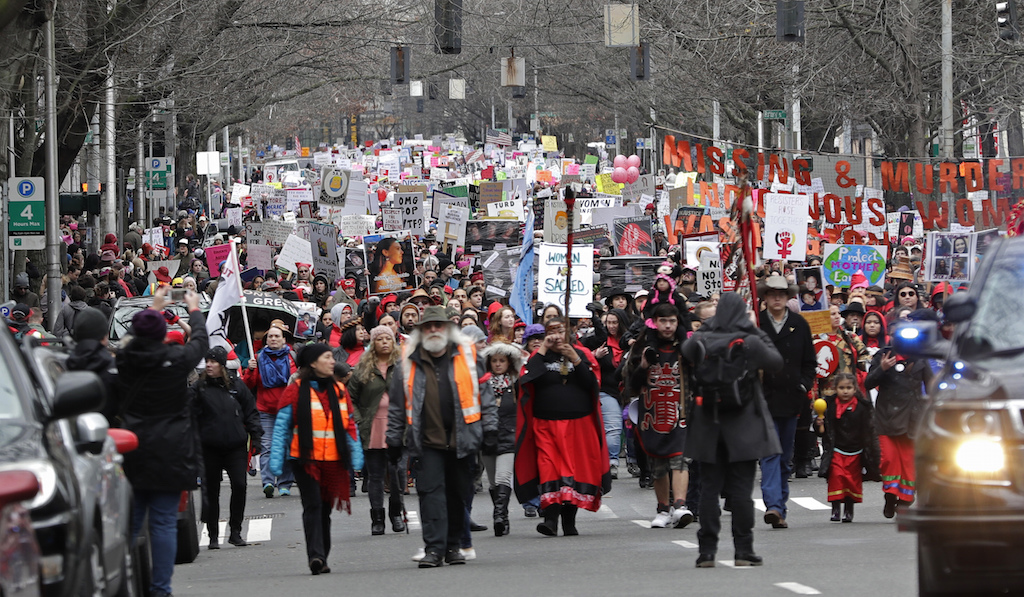No Indigenous Women, No Women’s Movement
Since the first wave of feminism, the struggle for gender equality has been a white woman's crusade. That has to change. Indigenous women wearing red to honor and remember missing and murdered indigenous women lead marchers in downtown Seattle during the 2018 Women's March. (Ted S. Warren / AP)
Indigenous women wearing red to honor and remember missing and murdered indigenous women lead marchers in downtown Seattle during the 2018 Women's March. (Ted S. Warren / AP)
It is no secret that, beginning with the first wave of feminism, the women’s movement has been a white woman’s crusade. While white women championed suffrage in the late 19th and early 20th centuries, black and indigenous women still were fighting for their personhood, not yet even considered human by the white race and simply not in the privileged position to be discontented with their inability to vote.
Still today, white and upper-class women’s issues stand in stark contrast to the issues of many indigenous and black women. In today’s women’s marches across the nation, scores of white women express their feminist vigor wearing pink pussy hats, a rebuff to Donald Trump’s “grab ’em by the pussy” comment from a 2005 “Access Hollywood” recording that emerged publicly shortly before the 2016 presidential election. Groups of indigenous women stood in visible contrast at these marches, wearing red in honor and remembrance of the epidemic of missing and murdered indigenous women (MMIW) in the United States and Canada, a tragedy left unspoken about by the masses of white women and all of the mainstream.
Many Native American women floated through the marches in floor-length ribbon skirts or their traditional tribal attire, long hair down their backs or fixed in traditional style. But indigenous women don’t just appear different in their politics. Today, the goals of indigenous women are as disconnected—if not different—as they were in the first, second and third waves of feminism.
The term “feminism” itself, continues to be debated in tribal communities. Some reject the term, and other indigenous women qualify their feminist politics with the more appropriate term “indigenous feminism.”
In 2000, indigenous scholar Laura Tohe of the Diné (Navajo) wrote: “There is no word for feminism in my language,” affirming, “there was no need for feminism because of our matrilineal culture.” With the Diné, the women traditionally owned the property. As with virtually all precolonial indigenous cultures, to be a mother among the Diné was to be a creator, a tremendous honor and privilege, not the burden or reductive societal role many white women lamented in the 1970s.
The lived experiences of indigenous women have been and continue to be different from those of white women. Regardless of this disparity, indigenous women bring valuable and necessary contributions to this most recent wave of American feminism.
Indigenous women—like Tohe and those wearing red in ongoing demonstrations across the continent in honor of missing and murdered indigenous women—seek to rematriate indigenous spaces and realities, or reconnect to matriarchy and the egalitarian roots of this land. Rematriation is a process of recognition that matriarchy begins first with the acknowledgement of the earth as mother to all life. When the earth, a feminine source, is honored and respected, balance is achieved at the most foundational level of human existence.
Indigenous feminists know that the patriarchy alone has not oppressed and ravaged indigenous women and their communities. A much deeper and more intricate system of power is responsible for the last five centuries of physical and spiritual assaults on the first women of this land and their entire communities. Arriving on so-called American shores in 1492, settler colonialism brought patriarchy, capitalism, racism and rugged individualism. All of those systems have devastated indigenous nations and cultures. This same interrelated system of power, many indigenous people understand, is responsible for human rights violations across all genders and cultures.
Moving forward, white feminists must realize that racism and sexism do not exist separately. So long as the white-led feminist movement does not center the discussion of racism in its layers of politics, sexism will remain attached to this country’s racist roots. Many more underwhelming waves of feminism will come and go after this one, devoid of the core understanding of the interrelated threads of American inequity and power imbalance.
In 1972, Joan Didion wrote an important essay, “The Women’s Movement,” that expressed distaste for the white-led women’s movement of that era. Didion saw a contrast between women of color’s feminism struggling out of necessity and white women’s feminism lacking the same urgency.
Not much has changed since Didion’s critique. Today, black women and indigenous women set themselves apart from white feminism by pointing to its failings for all women.
“Keep your pussy hats off my feminism,” wrote Taylyn Washington-Harmon, a black woman who did not participate in the women’s march this year, in an article for Self. “There is still a lot of progress to be made when it comes to pushing for a feminism that is truly intersectional, inclusive of women and femmes of color, and welcoming and protective of trans and gender non-conforming women,” she explained.
Some of the women’s marches, though, did some things right this year, prioritizing intersectionality and welcoming to the event a rematriation of the space—an acknowledgement of the first women, recognizing the indigenous women of that particular land. This is an important start to deepening and revolutionizing the women’s movement.
In downtown Reno, Nev., women of the Paiute, Washoe and Shoshone tribes led the march, with ornately dressed jingle dress dancers charting the path for the crowd in their healing dresses, indigenous men and women trailing behind them in traditional song.
In Seattle, indigenous women of Pacific Northwest tribes led the march with red banners for MMIW. Later in the program, many spoke out, through microphones with sound reverberating over the crowd, speaking on the epidemic of missing and murdered indigenous women and ongoing struggles in their communities that have long been ignored.
In Minneapolis, Korina Barry, an Anishinaabe woman who is a candidate for the state Legislature, spoke to a massive crowd, acknowledging missing and murdered indigenous women and the indigenous fight against oil pipelines in the state. She also acknowledged that where the marchers gathered that day was upon the beloved territory of the Dakota people, exiled from their home state of Minnesota after the 1862 Dakota conflict.
When white feminists and all feminists alike bear down to do the consistent work of recognizing that the land upon which they stand is indigenous land, the women’s movement will make more substantive movement. In fact, all social movements will make more movement.
Wherever women’s marches are, wherever feminist conversations are, wherever social movements are, remember indigenous women, and remember indigenous peoples.
Acknowledge them.
Then pass the mic.
Your support is crucial…With an uncertain future and a new administration casting doubt on press freedoms, the danger is clear: The truth is at risk.
Now is the time to give. Your tax-deductible support allows us to dig deeper, delivering fearless investigative reporting and analysis that exposes what’s really happening — without compromise.
Stand with our courageous journalists. Donate today to protect a free press, uphold democracy and unearth untold stories.






You need to be a supporter to comment.
There are currently no responses to this article.
Be the first to respond.